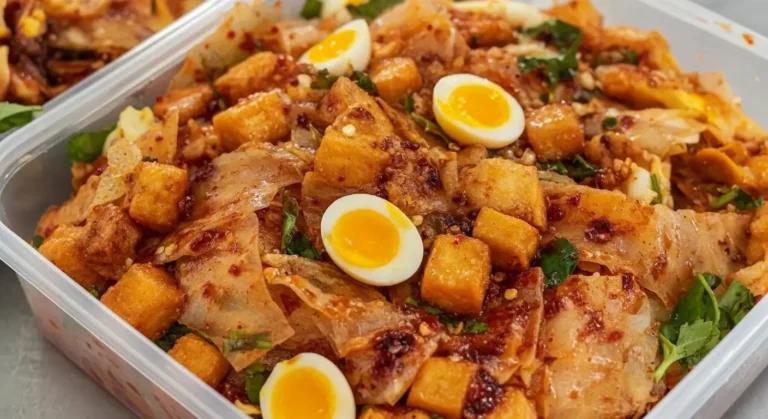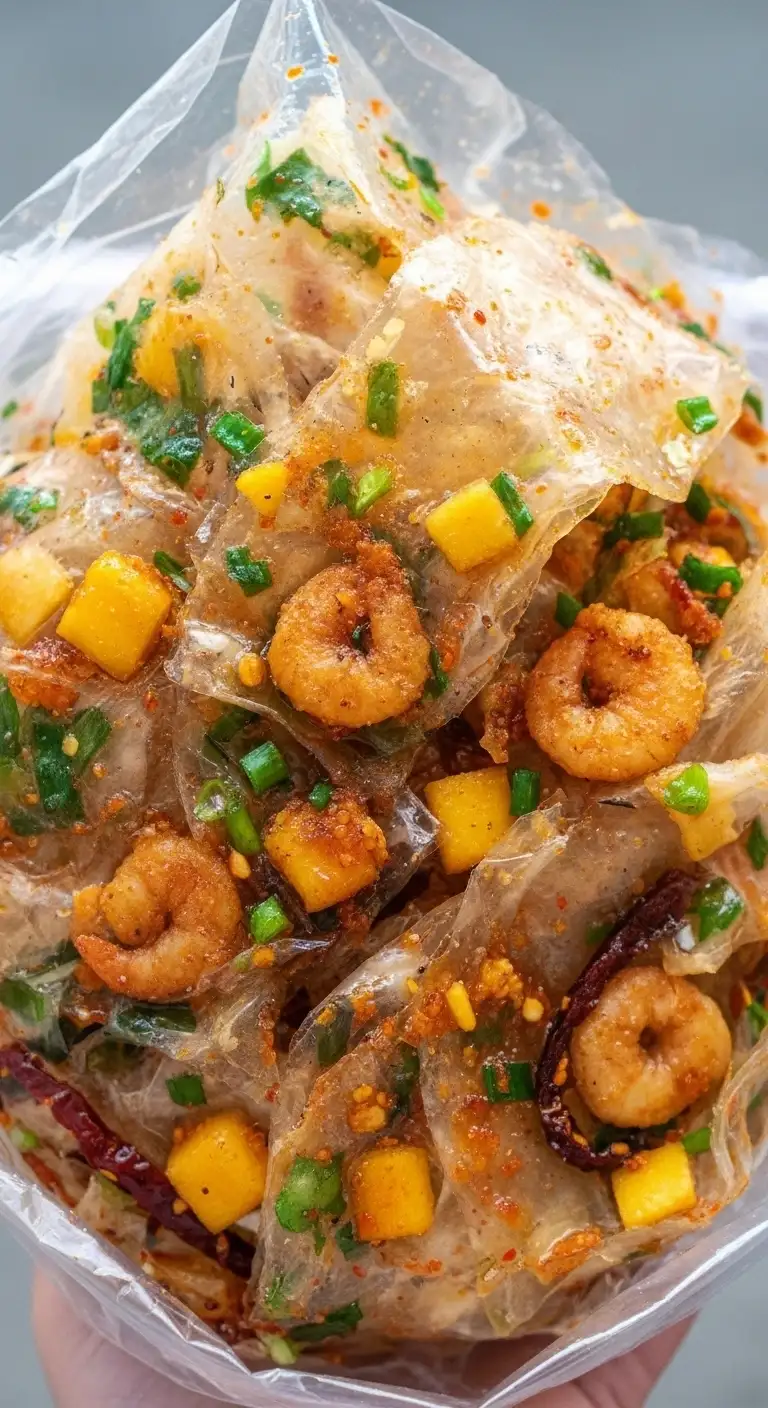Bánh Tráng Trộn, often translated as “Mixed Rice Paper” or “Vietnamese Rice Paper Salad,” is a vibrant and modern street food sensation. Originating from Southern Vietnam, this snack has become famous nationwide for its explosive combination of sour, sweet, salty, spicy, and savory flavors, along with a thrilling contrast of textures.

Bánh Tráng Trộn: The Basics
The Dish: Bánh Tráng Trộn is essentially a savory salad where the main component is not lettuce, but rice paper. The shredded rice paper strips are the “noodles” of this dish, soaking up the flavorful sauce and softening into a chewy texture.
The Ingredients: The magic lies in the eclectic mix of toppings and seasonings, which provide layers of flavor and texture:
Rice Paper (Bánh Tráng): Cut into thin, manageable strips.
Green Mango: Julienne-cut, unripe mango is essential, providing the characteristic sour and tangy flavor.
Protein/Savory: Vietnamese dried beef jerky (Bò Khô), small dried shrimp, and boiled quail eggs.
Seasonings & Herbs: Fried shallots, roasted peanuts, chili oil (sa tế), Vietnamese coriander (rau răm), and a specialty shrimp salt (muối tôm).
The Sauce: A tangy, sweet, and complex dressing often made with tamarind paste, calamansi (or lime) juice, sugar, and fish sauce.
The Experience: It is a perfect snack for Vietnam’s tropical heat—refreshing, spicy, and packed with energy. It is celebrated for its dynamism, earning the nickname “Vietnam in a bag” by one celebrity chef.
Bánh Tráng Trộn: A Single, Customizable Dish
Bánh Tráng Trộn is not a category with different recipes, but rather a singular concept (shredded, mixed rice paper) that is highly customizable with various toppings.
The Classic Form: The most popular and standard rendition includes all the core ingredients: shredded rice paper, green mango, bò khô (beef jerky), quail eggs, rau răm, and the tamarind/chili sauce.
Common Variations/Toppings (Add-ons): Vendors often allow customers to select specific additions:
Pork Crackling (Tóp Mỡ): For an extra fatty crunch.
Scallion Oil (Mỡ Hành): Oil infused with fried scallions, adding a rich, aromatic element.
Fish Cake (Chả Cá): Sliced fried fish cake pieces.
Alternative Protein: Some may substitute the beef jerky with shredded dried cuttlefish or omit meat entirely.
The defining characteristic remains the trộn (mixing) of the shredded rice paper with the sour, tangy, and spicy seasonings.

How to Eat Bánh Tráng Trộn
The beauty of Bánh Tráng Trộn lies in its simplicity and portability as a street food.
The Preparation: The vendor places all the ingredients, including the rice paper strips, proteins, herbs, and seasonings, into a bowl. The sauce (often a blend of chili oil, shrimp salt, and a tamarind mixture) is then drizzled over the top.
The Mixing Ritual: The vendor, or the customer, thoroughly tosses the salad. The key is ensuring the rice paper strips are coated and begin to soften, transitioning from brittle to chewy, while still retaining the crunch of the mango and peanuts. Locals often use their gloved hands to quickly and gently massage the ingredients for the perfect mix.
Serving: The finished salad is transferred into a small, clear plastic bag or box, sealed, and handed over with a pair of chopsticks or a small skewer.
Enjoy: The dish must be eaten immediately while the textures are at their prime—the chewy rice paper, crunchy peanuts, and soft quail eggs should all be enjoyed simultaneously. It’s typically eaten on the spot as a snack.
Regional Differences
Bánh Tráng Trộn is a relatively modern dish that exploded in popularity, and while widely available now, it still maintains its strong identity as a Southern Vietnamese creation. Regional differences are subtle and mainly concern the primary ingredients used in the rice paper itself.
South Vietnam (Nam): This is the heartland of the dish, and the Southern version is considered the definitive one.
Flavor Profile: Aligns with the Southern culinary preference for bolder, sweeter, and tangier flavors. The tamarind/calamansi sauce is pronounced, and it is usually very spicy.
Rice Paper: Southern rice paper (Bánh Tráng) typically includes tapioca starch, giving the sheets a characteristic thin, soft, and slightly chewy texture, ideal for soaking up the dressing.
North and Central Vietnam (Bắc & Trung):
Availability: The dish is popular in Northern and Central cities but is an adopted street food rather than a historical staple.
Flavor Adaptation: While the core ingredients remain the same, Northern and Central versions might be less sweet and rely more heavily on savory and salty elements to align with regional palates (e.g., more use of fish sauce or chili powder over sugar).
Rice Paper: Traditional Northern rice paper (Bánh Đa Nem) is sometimes made with less starch and is thinner. Vendors in these regions may use different varieties of rice paper, which can alter the final chewy texture of the salad compared to the Southern version.
In summary, the best and most authentic version, characterized by its intensely sweet, sour, and savory balance, is found in the street stalls of Southern Vietnam.




